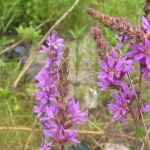| Common Name: |
Purple Loosestrife |
| Botanical Name: |
Lythrum salicaria |
| Genus: |
Lythrum |
| Family: |
Lythraceae |
| Native Location: |
Europe, Asia, N Africa |
| Cultivation: |
Moist to wet, neutral to alkaline soil, or shallow water in sun or partial shade. Import of plants and seeds is prohibited in parts of the USA and Canada. |
| Propagation: |
By seed sown at 13-18°C (55-63°F) in spring (species only); by division in spring; by basal cuttings in spring or early summer. Self-sows readily in damp conditions. |
| Harvest: |
Plants are cut when in flowers and used fresh, or dried for use in decoctions and infusions. |
| Variations: |
Feuerkerze
syn. Firecandle
Has bright rose-pink flowers.
Height: 90cm (36in) |
Happy
Is dwarf, with small leaves and deep pink flowers.
Height: 60cm (24in) |
Lady Sackville
Has deep pink flowers
Height: 90cm (36in) |
Robert
Has a compact habit and bright pink flowers.
Height: 90cm (36in) |
|
| Height: |
60cm-1.5m (2-5ft) |
| Width: |
45cm-1.2m (1.5-4ft) |
| Hardiness: |
Z4-9 |
| Parts Used: |
Whole Plant |
| Properties: |
A highly astringent, anti-bacterial herb that is diuretic, soothes irritated tissues, and controls bleeding. |
| Medicinal Uses: |
Internally for diarrhea, dysentery, cholera, typhoid, typhus, hepatitis, hemorrhage, excessive menstruation, and vaginal discharge. Externally for wounds, sores, impetigo, eczema, eye infections, and vaginal discharge. Combined with Gnaphalium uliginosum (See, Marsh Cudweed) as a gargle for sore throat. |
| Bibliography: |
Encyclopedia of Herbs by Deni Brown Copyright © 1995, 2001 Dorling Kindersley Limited Pp 268-269 |

